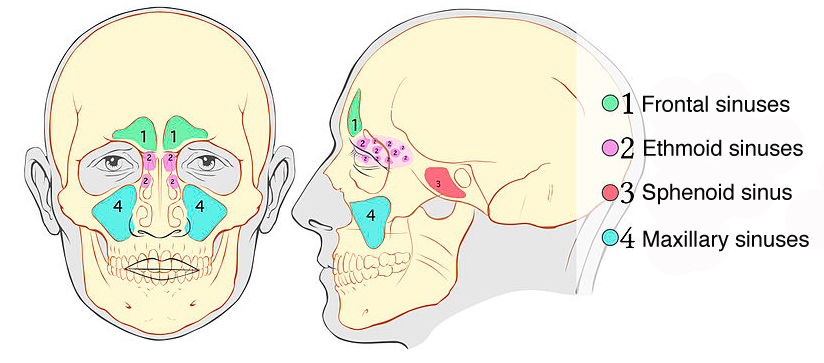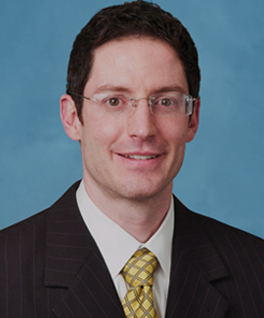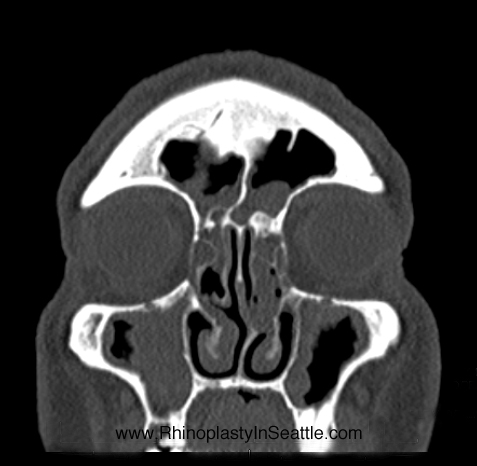Sinus Surgery
Chronic sinus infections can take a lot out of you. From chronic facial pain and headaches to missed work or school persistent sinusitis can have an enormous toll on your quality of life. Find out more about the sinuses and which sinus treatment option may be right for you.
What are the sinuses?
The sinuses are a group of air cavities within the bones of the face the drain into the nasal cavity. The specific sinus cavities include:
- Frontal sinuses which are located over the brow and forehead region
- Ethmoid sinuses which are located between the eyes
- Sphenoid sinuses which are located toward the back of the nasal cavity
- Maxillary sinuses which overlay each cheek

How do the sinuses function?
The sinuses are lined by a thin layer of nasal skin lining called mucosa. The skin lining normally produces a thin layer of mucous which is circulated out of each sinus and into the nasal cavity thanks to special hair cells or cilia located on the sinus skin lining. Other than this layer of mucous the sinuses are otherwise empty.
What causes an acute sinus infection?
A sinus infection occurs when the normal outflow of sinus mucous is hindered by one of various causes. A viral infection or allergies can commonly lead to increased mucous production and swelling of the nasal and sinus skin lining. If severe enough this can ultimately cause a blockage of one or more sinus cavities. This results in a backup of mucous within the sinus which can lead to significant pain and pressure.
Treatment is aimed at reducing the swelling. This can involve using decongestants, saline rinses and anti-allergy medication. If the swelling persists a bacterial infection can then develop and an antibiotic course may be needed.
Acute sinusitis refers to an episode that lasts 4 weeks or less. Common symptoms include facial pressure, tooth ache, thick nose drainage, fever, post nasal drainage and nasal congestion.
What is chronic sinusitis?
Chronic sinusitis occurs when there is chronic inflammation in the sinuses lasting 3 months or longer. The symptoms of chronic sinusitis are similar to acute sinusitis, but they tend to be somewhat milder and last longer.
Treatment often includes a prolonged course of antibiotics for up to 3 or 4 weeks. It is also common to start a steroid nasal spray to help reduce nasal cavity inflammation. If allergies are suspected an anti-histamine may also be used. Further reduction of mucosal swelling may be addressed with a short oral steroid course.
What causes chronic sinusitis?
Chronic sinusitis can have several possible causes including:
- Nasal polyps or other nasal tumors. Nasal polyps form in some people as a result of chronic nasal inflammation. These benign growths gradually enlarge to block the sinuses and nasal cavity. The CT scan above shows a patient with diffuse nasal polyps and chronic sinusitis. Find out what a nasal polyp looks like inside the nose here.
- Nasal allergies. Chronic untreated nasal allergies can lead to persistent inflammation of the nasal and sinus mucosa which can lead to sinus blockage.
- Septal deviation. A deviated nasal septum can block the natural drainage pathway within the sinuses. See what a deviated nasal septum looks like here.
- Allergic fungal sinusitis. A fungal infection or allergic fungal response can lead to chronic nasal and sinus inflammation.
When is sinus surgery needed?
Sinus surgery becomes a consideration in people who have frequent recurrent sinus infections (2 to 3 a year) despite a trial of medical therapy including steroid nasal spray and anti-allergy treatment. In those with severe allergies allergy shots may be useful as well. Sinus surgery is also an option for patients who have a chronic infection that persists longer than 3 months despite treatment with medications.
Are you a sinus surgery candidate?
To find how if sinus surgery may be helpful you should be seen by an otolaryngologist (ear, nose, throat doctor) who performs sinus surgery. This will allow for a thorough history and physical exam. Your doctor will also be able to exam your nasal cavity looking for possible anatomic causes of your sinus symptoms. This includes determining whether you have nasal polyps, a deviated nasal septum, enlarged turbinates, or enlarged adenoids. It is also important to look for signs of active infection such as pus draining from the sinuses.
A part of this examination may include the placement of a very small endoscope into the nose to further evaluate your nasal anatomy, including the visualization of where the sinuses drain into the nose.
You can see what this endoscopic view of the nasal cavity looks like below:
It usually is not possible to see into the sinuses themselves while in the office. To further evaluate the sinuses your otolaryngologist may order a sinus CT scan. This is a type of radiologic imaging that provides a 3-dimensional view of the sinus and nasal structures.
What does Functional Endoscopic Sinus Surgery (FESS) involve?
Sinus surgery is done in an operating room while the patient is asleep under anesthesia. Sinus surgery is directed only toward those sinuses which show signs of chronic sinusitis. At its essence sinus surgery involves opening up the natural sinus openings so that they drain properly into the nose.
Another name for sinus surgery is Functional Endoscopic Sinus Surgery (FESS). This is differentiated from an older style of sinus surgery in which openings were made in the sinuses in a totally separate part of the sinus, rather than using the existing, functional opening. It turns out that this older method does not work as well since the cilia within the sinuses continue to try to whisk the mucous to the original opening, rather than the non-functional one.
How is FESS performed?
There are many variations among surgeons in how sinus surgery is specifically done. Typically, a small fiberoptic endoscope (or telescope) is used visualize the inside of the nose and sinuses during surgery. This endoscope provides a magnified and well lit view of the surgical field.
The surgery is then directed toward the affected sinus or sinuses. Small forceps and shavers can be used to trim the thin bone that forms the opening of the sinuses. If nasal polyps are present these will also be removed along with chronically inflamed skin lining.
An additional option is to dilate narrowed sinus openings using a balloon. Learn more about the Balloon Sinuplasty procedure here.
Related Sinus Surgery Resources:
Watch a video that shows how Dr. Lamperti is able to open up the cheek sinus using maxillary antrostomy technique here.

Meet Plastic Surgeon, Dr. Lamperti
Dr. Lamperti, a Seattle rhinoplasty super-specialist, has devoted his career to treatments of the head, face and neck. He feels that by focusing his plastic surgery endeavors solely to the face he is best able to provide the excellent results his patients desire.
Interested in learning more about having a Rhinoplasty Treatment in Seattle with Dr. Lamperti?
Contact us to have a private consultation or view Before & After photos here.
